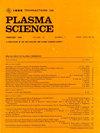Terahertz Planar Amplifier With Spoof Surface Plasmon Polariton Modes Based on Meta-Composite Slot Slow Wave Structures
IF 1.3
4区 物理与天体物理
Q3 PHYSICS, FLUIDS & PLASMAS
引用次数: 0
Abstract
To reduce the manufacturing difficulty of the slow wave structure (SWS) and enhance integration with passive devices for realizing terahertz (THz) integrated circuits (ICs), a spoof surface plasmon polariton (SSPP) mode planar SWS based on a meta-composite slot (MCS) SWS is proposed. The SSPP mode is employed in the MCS-SWS, which enables the enhancement of longitudinal field in the beam-wave interaction region, thus achieving an average interaction impedance of the first-order spatial harmonics over基于元复合槽慢波结构的欺骗表面等离子激元模式太赫兹平面放大器
为了降低慢波结构(SWS)的制造难度,提高与无源器件的集成度,实现太赫兹(THz)集成电路,提出了一种基于元复合槽(MCS) SWS的欺骗表面等离子激元(SSPP)模式平面SWS。MCS-SWS采用SSPP模式,增强了波束波相互作用区域的纵向场,从而在340 GHz时实现了一阶空间谐波的平均相互作用阻抗在4.7~\Omega $之间。此外,利用双电偶极子模型阐明了MCS-SWS产生场增强的物理机制。此外,通过场分析,提出了一种有效的抑制后向波振荡的策略。电池内粒子(PIC)实验结果表明,在电压为10.6 kV、电流为50 mA的双片电子束(SEB)条件下,341 GHz频率下的最大饱和输出功率可达26.7 W。相应的单位长度增益为1.93 dB/mm,电子效率为2.52%。得益于如此高的单位长度增益,SWS的总长度仅为10.8 mm,比相同频段的传统行波管(TWT)短得多。这些指标表明,MCS-SWS有很大的潜力作为太赫兹放大器的核心用于太赫兹ic。
本文章由计算机程序翻译,如有差异,请以英文原文为准。
求助全文
约1分钟内获得全文
求助全文
来源期刊

IEEE Transactions on Plasma Science
物理-物理:流体与等离子体
CiteScore
3.00
自引率
20.00%
发文量
538
审稿时长
3.8 months
期刊介绍:
The scope covers all aspects of the theory and application of plasma science. It includes the following areas: magnetohydrodynamics; thermionics and plasma diodes; basic plasma phenomena; gaseous electronics; microwave/plasma interaction; electron, ion, and plasma sources; space plasmas; intense electron and ion beams; laser-plasma interactions; plasma diagnostics; plasma chemistry and processing; solid-state plasmas; plasma heating; plasma for controlled fusion research; high energy density plasmas; industrial/commercial applications of plasma physics; plasma waves and instabilities; and high power microwave and submillimeter wave generation.
 求助内容:
求助内容: 应助结果提醒方式:
应助结果提醒方式:


